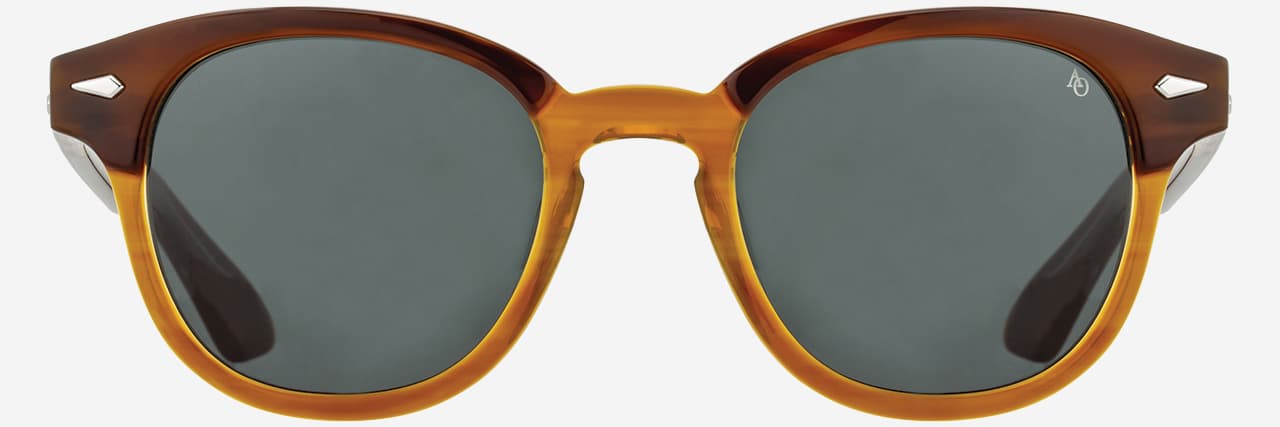
Measuring Your Face to Find Your Sunglasses Size
How to measure your face to choose sunglasses size?
Finding the perfect pair of sunglasses can be a daunting task, especially when it comes to choosing the right size.
A poorly fitting pair of glasses can not only feel uncomfortable, but also fail to provide proper protection from harmful UV rays. That's why measuring your face correctly before purchasing a new pair of frames is crucial.

In this blog post, we'll guide you through the simple steps of measuring your face to determine the ideal sunglasses size for you.
So, let's get started and find your perfect fit!
Do Sunglasses Have Sizes?
Yes, sunglasses do come in different sizes. Just like clothing or shoes, sunglasses are available in various sizes to accommodate different face shapes and sizes.
A proper fit is essential to ensure maximum comfort and protection from the sun's harmful rays. Glasses sizing is measured in millimeters and consists of three numbers - first the lens width, then the bridge width, and finally, the temple length. The lens width is generally the most important measurement to focus on when shopping.
Understanding these measurements and knowing how to measure your own face can help you find the perfect fitting sunglasses that not only look great but also provide the necessary protection for your eyes.
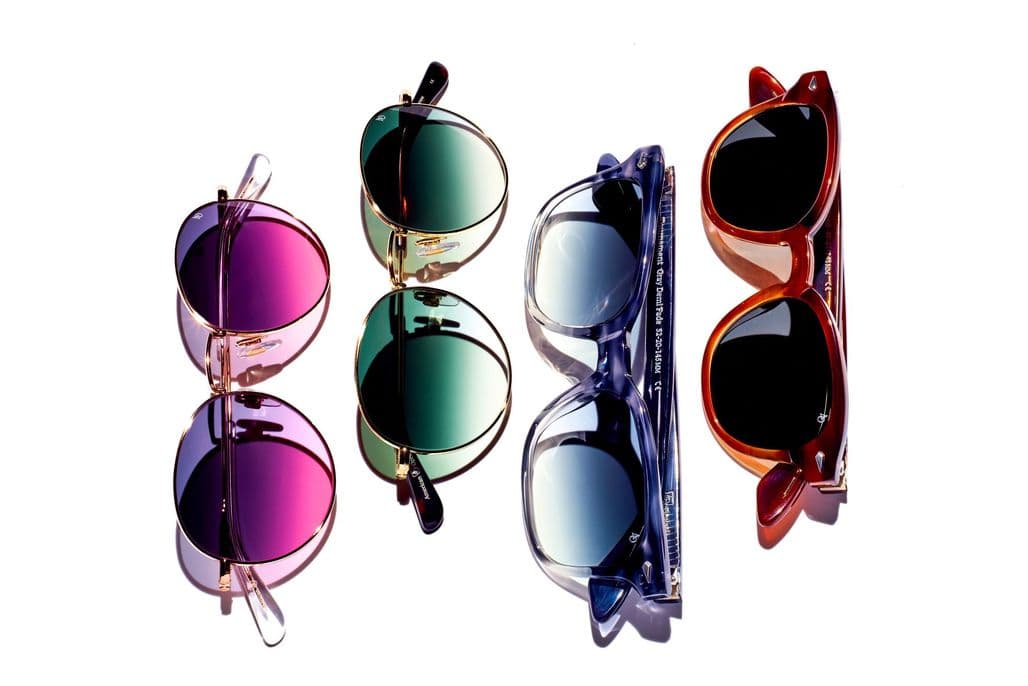
Broadly, we can classify frames as small, medium (or average), and large.
- Small Sunglasses have an eye size between 47 and 52 and fit similarly to eyeglasses
- Medium Sunglasses have an eye size between 53 and 55 to provide more UV protection.
- Large Sunglasses have an eye size 56 and up and are designed to fit larger faces or provide an oversized look.
Is There an Average Sunglasses Size?
There is no one "average" size for frames as everyone's face shape and size is unique.
However, generally, adult sunglasses range in size from 49mm to 62mm in lens width, with the bridge width typically being between 16mm to 24mm, and temple length ranging from 135mm to 150mm.
Every face is unique and all sunglasses have different fitting properties, so finding your perfect fit can be more involved than focusing on one number. You may prefer shopping according to your face shape, rather than trying to measure your face size.
What Is Proper Sunglasses Fit?
Proper fit refers to a comfortable and secure fit that provides the necessary level of protection from the sun's harmful rays.
Sunglasses should fit snugly on the face without being too tight or causing any discomfort or pressure points. The lenses should cover the eyes completely and be positioned correctly, without obstructing your vision or letting light in from the sides. Frames should also sit level on the face, without tilting or sliding down.
A proper fit not only ensures optimal protection but also enhances comfort and allows you to enjoy activities without distractions or discomfort.
Based on your personal style and lifestyle, you may be looking for a narrow, standard, or oversized fit. The way frame measurements work together, and based on your face size and shape, similar measurements can provide different fits for different people.
- Narrow fit - a smaller lens and narrower bridge provide a fit that's snug and close to your head. The lenses will cover less of your face.
- Standard (Regular) Fit - a comfortable fit with expanded coverage for UV protection
- Oversized Fit - frame width may be wider than your face and will provide the most facial coverage
Even if you feel you know the right size for you, it's always important to use our virtual try-on feature, or visit an authorized retailer, to see how each style will look on you.
Why Is Choosing the Correct Sunglasses Size Important?
Choosing the correct sunglasses size is important for several reasons.
- UV Protection - Firstly, a proper fit ensures that the sunglasses provide adequate protection from harmful UV rays. Frames that are too small or too large can allow harmful rays to enter around the edges of the lenses, increasing the risk of eye damage and vision problems.
- Comfort - Secondly, a well-fitting pair of frames can provide maximum comfort and prevent distractions while engaging in outdoor activities.
- Aesthetics - Finally, wearing the correct size can enhance style and overall appearance. Overall, choosing the correct size is essential for protecting your eyes and enjoying your time outdoors comfortably and in style.
3 Types of Sunglass Measurements
-
Eye size (or frame size) -
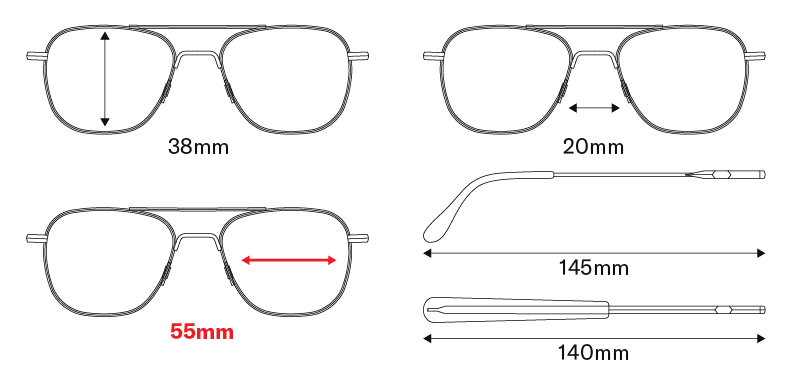 Sunglasses eye size refers to the measurement of the width of the lenses of a pair of sunglasses. This measurement is taken horizontally, at the widest point of the lens.
Sunglasses eye size refers to the measurement of the width of the lenses of a pair of sunglasses. This measurement is taken horizontally, at the widest point of the lens.Some people refer to frame size as the total width across the frame front - endpiece to endpiece. Using eye size is a more reliable and informative measurement, but you can always contact our customer care team if you need a full frame width measurement.
-
Bridge size -
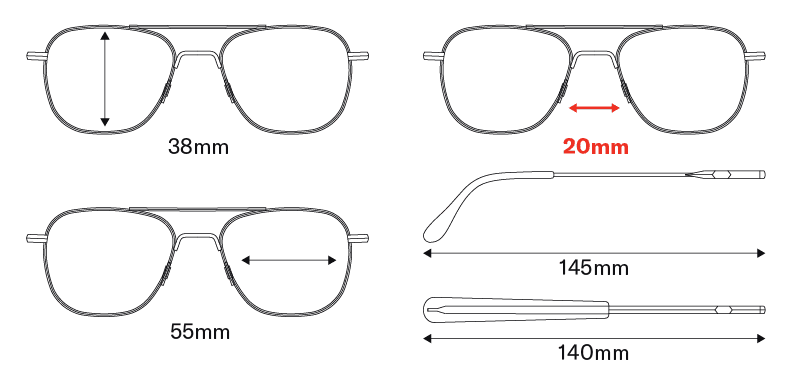 Bridge size refers to the measurement of the distance between the two lenses of a pair of sunglasses, where the frame rests on the nose. This measurement is taken in millimeters and is important to consider when selecting a pair of sunglasses because it affects the fit and comfort of the sunglasses on the face.
Bridge size refers to the measurement of the distance between the two lenses of a pair of sunglasses, where the frame rests on the nose. This measurement is taken in millimeters and is important to consider when selecting a pair of sunglasses because it affects the fit and comfort of the sunglasses on the face. -
Temple size -
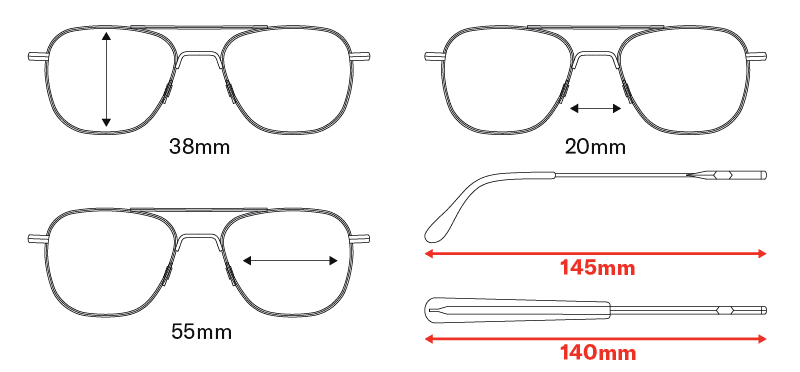 Temple size refers to the length of the arms or "temples" of a pair of sunglasses, which extend from the hinge of the frame to the back of the ear. The temple size measurement is taken in millimeters and is an important factor to consider when selecting a pair of sunglasses because it affects the fit and comfort of the sunglasses on the face.
Temple size refers to the length of the arms or "temples" of a pair of sunglasses, which extend from the hinge of the frame to the back of the ear. The temple size measurement is taken in millimeters and is an important factor to consider when selecting a pair of sunglasses because it affects the fit and comfort of the sunglasses on the face.
How to Measure Your Face for Sunglasses?
Grab a ruler or tape measure, a mirror, and a selfie camera and we'll walk you through what all this means based on your face size.
-
Find Your Lens Width or (Frame Width) Measurement
Pull out your tape measure or ruler. To determine the total width of your glasses, place the ruler just below your eyes and measure the distance between your left and right temple. Be sure to measure straight.
Keep in mind that frame sizes refer to individual lens width. To calculate the ideal lens width, subtract your bridge measurement from your temple measurement and divide the resulting number in half.
This doesn't have to be exact, most people find that there is a range of lens sizes that fit them well.
-
Find Your Bridge Measurement
Take a peek in the mirror or take a side-profile selfie to evaluate your bridge (the part of your nose between your eyes). Notice if it's wide or narrow, and high or low.
If your bridge falls level with or below your pupils or narrow, you'll want to look for a smaller bridge size. If your bridge starts above your pupils, a larger bridge size will likely fit you better.
If you've always had a hard time fitting your bridge, consider sticking to frames with adjustable nose pad arms (most metal styles).
-
Find Your Temple Length
Use your ruler to measure from over and behind your ear to the front of your face to get a rough estimate of the temple length you'll need. Remember that temples can be adjusted, so you mostly just want to rule out anything that is far shorter than your measurement.
What Size Sunglasses Do I Need?
Eye size is an important factor to consider when choosing frames because it affects the fit and coverage of the sunglasses on the face. It's important to select a frame size that matches the width of your face for optimal fit and protection.
A proper bridge fit is important because it helps to prevent sunglasses from sliding down the nose or causing discomfort or pressure points. Selecting the correct bridge size ensures that the sunglasses are comfortable to wear.
A proper temple fit ensures that the sunglasses sit securely on the face without being too loose or tight.
Here's how to interpret the measurements you took:
Sunglass Sizes Guide
| Face Width | Lens Measurement |
| Narrow (less than 129mm across) | Look for frames up to 50mm |
| Average (130 – 139mm) | Look for frames between 51 and 55mm |
| Wide (Over 139mm) | Look for frames 56mm and above |
Conclusion
In conclusion, choosing the right size of American Optical sunglasses is crucial for both protection and comfort.
Understanding how to measure your face and the different components of sunglasses sizing, such as lens width, bridge width, and temple length, can help you find the perfect pair of sunglasses for your face shape and size.
Take the time to measure your face and consider your personal preferences and needs when selecting sunglasses, and you'll be sure to find a pair that looks great and provides optimal protection and comfort.
Don't hesitate to contact us with any questions!

Sign up & save $10
Sign up to our newsletter and be the first to know about new, limited edition AO products, events and $10 off your first order!







